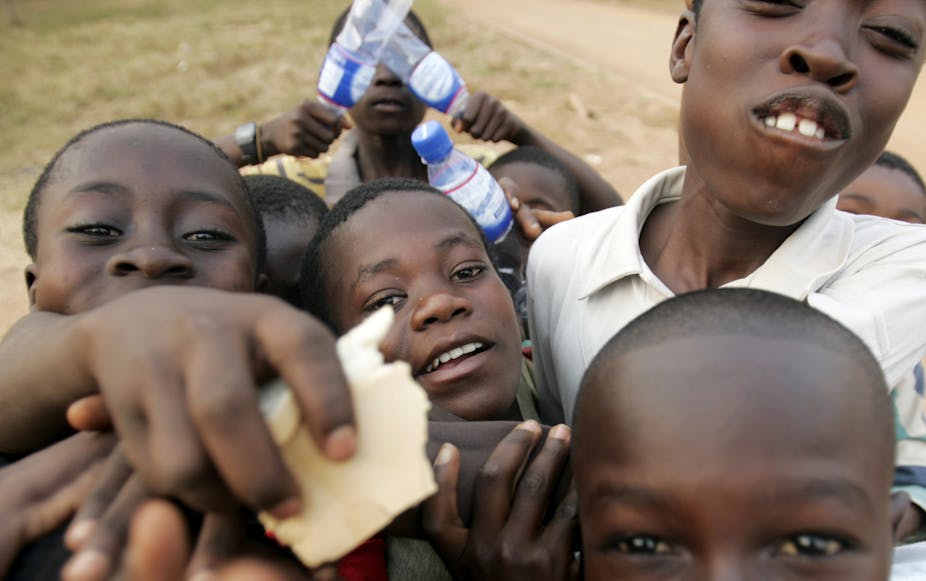Millions of Ghanaian children live in poverty. About one in ten – roughly 1.27 million – come from households that are so poor they can’t afford the amount and type of food that’s needed to stave off malnutrition.
Without proper food, children are prone to stunted growth or are underweight for their age. And their schooling suffers, too: research has repeatedly shown that children struggle to learn when they are not properly fed and nourished.
A school feeding programme introduced by the Ghanaian government more than a decade ago has gone some way to tackling the problem of hunger. The programme has reached millions of children – and it’s been proved to keep them in school far longer than their hungry peers. Now some more work is needed to make the project sustainable and to ensure it doesn’t constantly have to rely on donor funds.
Millions of children reached
The Ghana School Feeding Programme was initiated in 2005 by the country’s government in collaboration with the Dutch government. Its primary objectives are to increase school enrolment, attendance and retention among children in kindergartens and primary schools. It also, of course, aims to reduce hunger and malnutrition.
The programme started as a pilot project with ten schools, one from each of Ghana’s ten regions. This was later increased to 298 schools, reaching about 234,000 children in 138 schooling districts. In March 2016, it was reaching more than 1.7 million children every day – about 30% of all Ghanaian primary and kindergarten pupils.

Each day, children receive a hot, nutritious meal. This is made up of locally produced foods like rice, dried African locust bean seeds, African carp and sesame leaves, and of fortified food rations supplied by the World Food Programme. The rations include 150g of fortified corn-soy blend, 3g of iodised salt and 10g of palm oil per child per day.
There is also a second feeding category: girls in selected schools in Ghana’s three northern regions are given food to take home each time they attend school for 85% of the month. This food includes rice, maize, vegetable oil and iodised salt.
The ration programme for girls started in 1999 and has been gradually absorbed into the bigger school feeding programme. It has yielded remarkable results: girls’ enrolment in these selected schools has grown from 9,000 to 42,000 between 1999 and 2016. Retention rates have doubled to 99%. This scheme is essential in tackling gender disparity in education, particularly in northern Ghana’s food-insecure and deprived communities where girls’ education is not often prioritised by families.
Sadly the ration programme for girls is being slowly phased out – its managers believe their work is done given the huge spike in retention rates. Now the focus will be entirely on the bigger school feeding scheme, which has also been very successful. It has, according to my own research:
- increased school enrolment by 20%;
- reduced truancy and absenteeism;
- lowered school drop-out rates; and
- improved individual academic performance and the participating schools’ overall performance too.
These are all excellent, positive results. But there’s still work to be done.
Plotting the next steps
One of the biggest problems facing the programme is a lack of funding. It cannot be rolled out more widely because there just isn’t enough money.
Schools that aren’t currently part of the programme are struggling. A survey conducted in Ghana’s Sekyere Kumawu district found that non-beneficiary schools were actually losing pupils. The same study revealed that pupils were switching to the schools that offer the scheme in order to receive the benefits.
The government and stakeholders need to put mechanisms in place that will strengthen the existing programme, allow it to expand into other schools and make it sustainable. The government must wean the programme of its reliance on donor funds. It can learn here from the experiences of South Africa’s national school feeding programme, which is funded by the country’s National Treasury. This approach ensures that the government takes ownership of the programme and plans for its sustainability.
Policy will be important: the programme falls under Ghana’s National Social Protection Strategy, but should be bolstered with a strong legal and policy framework that clearly maps the way forward. This legislation should delineate the guidelines for implementation and institutional mechanisms to make sure the programme delivers what is necessary.
Finally, a robust monitoring and evaluation framework will be needed to ensure that the programme’s organisers learn from their failures and successes. This way adjustments can be made along the way so that Ghana’s children can keep getting the meals they need at school.

